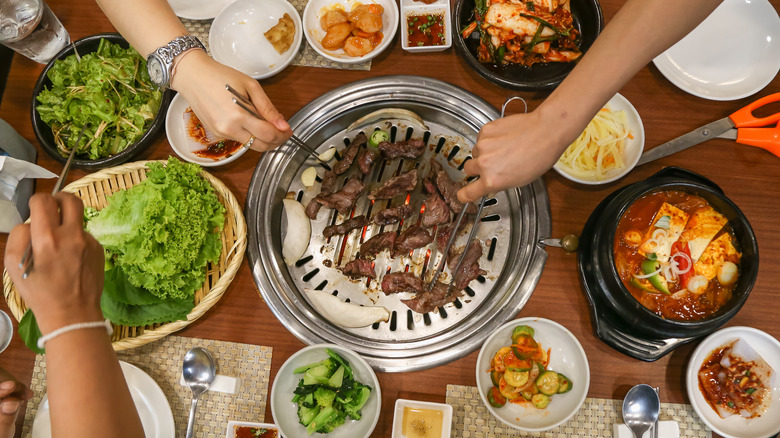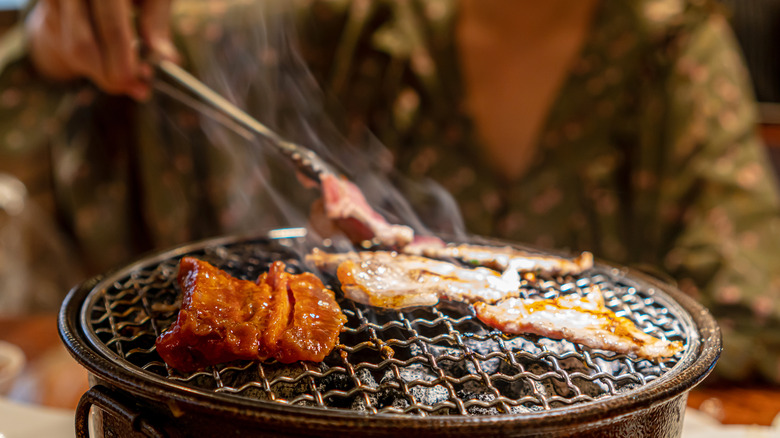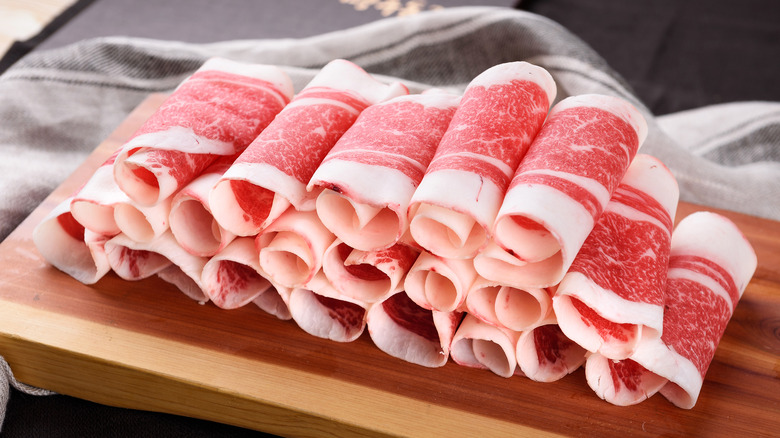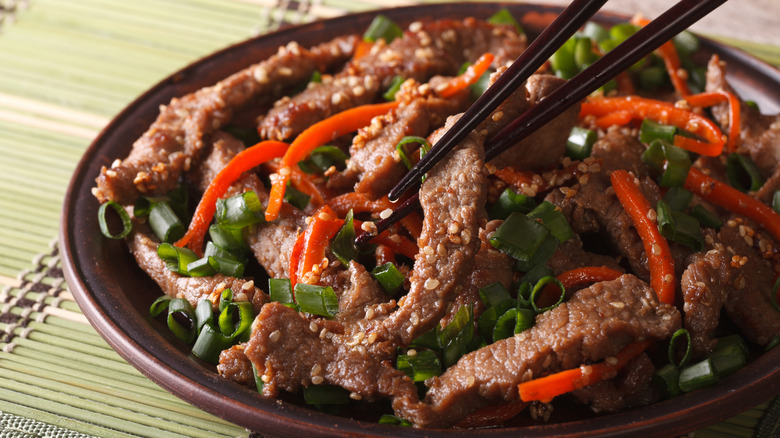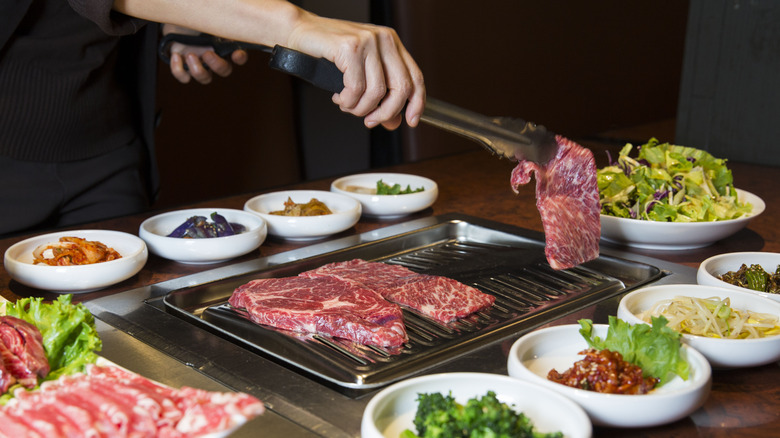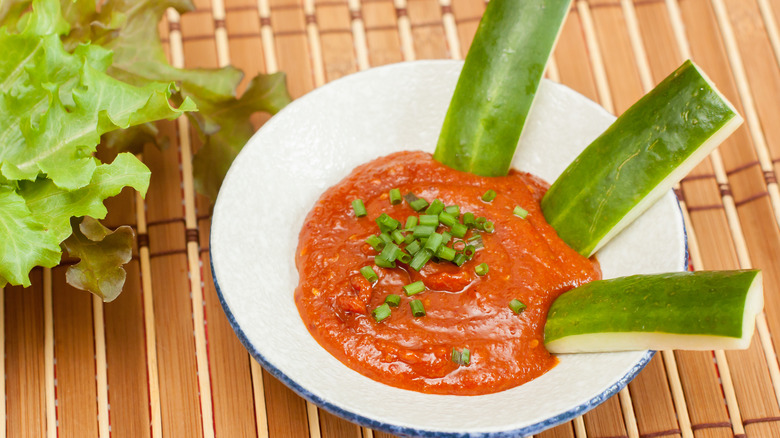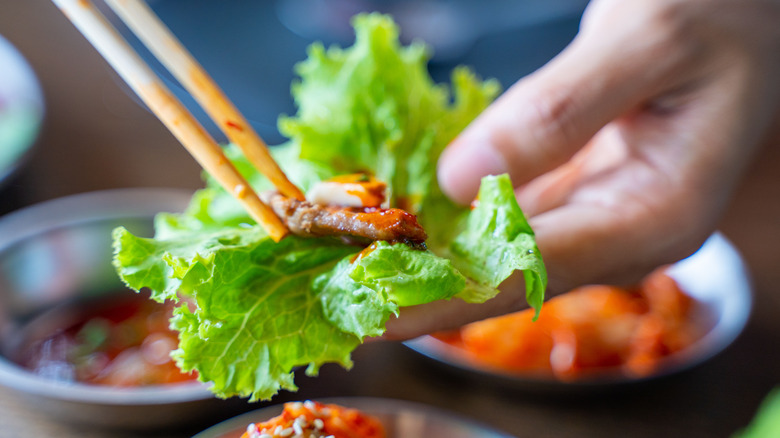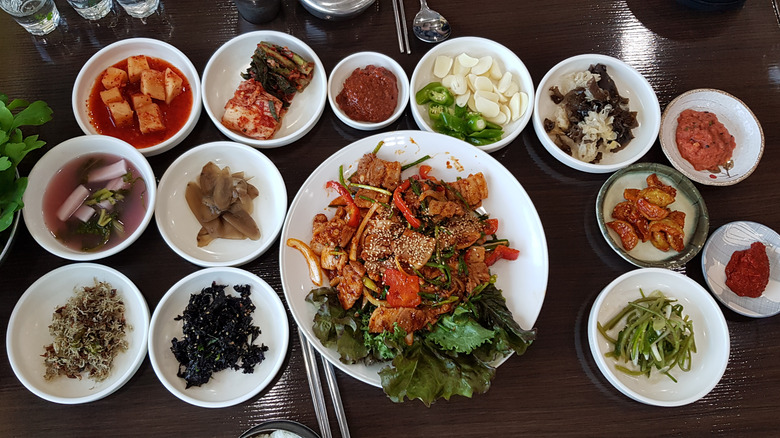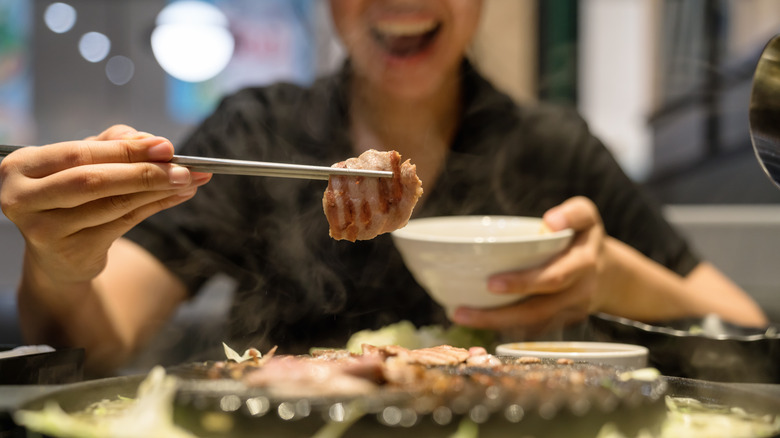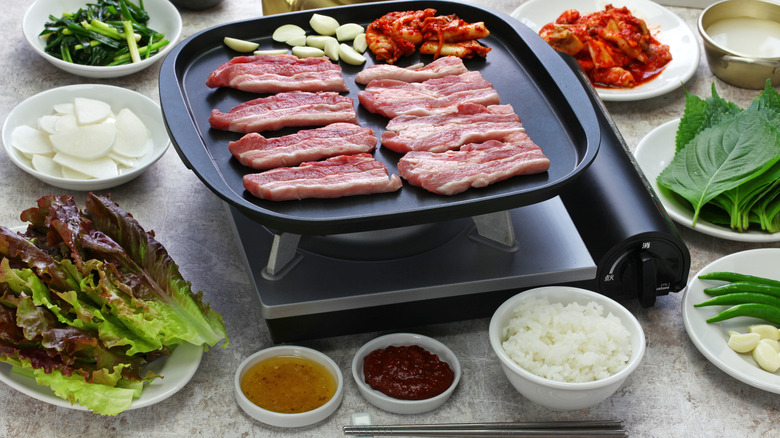Korean BBQ: Everything You Need To Know
There's so much more to Korean barbecue than simply being another version of what Americans regularly enjoy when the weather is nice. In fact, aside from the fact that you're grilling food, the majority of the aspects that comprise Korean barbecue are distinct. From equipment to novel flavors to the extra accouterments you'll find on your table, Korean barbecue is one of a kind. You can certainly fly to Korea to taste it at the source if you're so inclined, but Korean barbecue restaurants are increasingly popping up across the U.S.
You don't need any special skills to enjoy this delicious meal, but there are some elements that can boost your experience to the next level. For this reason, we've compiled everything you need to know about this dining style so that you can savor every moment. If you're on the lookout for a creative dinner party idea, you'll want to pick up our tricks for recreating the experience yourself. Once you try Korean barbecue, there's no turning back — you're going to want to start adding this diverse menu to your dinner rotation.
This isn't a solo outing
While there are some foods that are easily enjoyed alone, others are best consumed in the company of others. Apart from the convivial experience, Korean barbecue typically entails a fair deal of preparation and a large amount of food. To be able to taste the variety of marinades, meats, and side dishes, you're going to want to share with a group of hungry people.
If you're preparing the meal yourself at home, it's a lot of effort for one person. Meanwhile, as an article in Los Angeleno notes, many Korean barbecue restaurants don't allow solo diners. Though it might seem unfair, the work that goes into setting up and serving each table requires more time than the usual restaurant layout. Plus, the idea is to order a variety of items to grill, and portion sizes are designed for tables with multiple people.
Some restaurants might welcome solo diners, but Korean barbecue joints generally don't. In any case, you'll get more out of the experience if you go with a group, order a wide selection, and push the limits of your appetite. As The Korean Guide notes, Korean barbecue is more than just a meal, and sharing it with friends and family is part of the package.
The type of heat and grill affect the result
One of the most obvious ways in which Korean barbecue differs from the American version is the actual grill. Instead of a giant heavy-duty appliance on wheels, the grill is typically tabletop style. Consequently, it's an indoor activity — though you'll want to be sure to have all the windows open or opt for a smokeless grill if you're doing it at home.
Korean barbecue restaurants are set up with proper ventilation, but you'll probably still notice a lingering smell on your clothes when you get home. While the tabletop burner is usually integrated into the dining surface at restaurants, you don't have to redesign your kitchen if you want to try it out at home.
Per Food & Drink Destinations, Korean BBQ grills are powered by gas, electric, or charcoal, each with its own properties. With gas and electric grills, you have a lot more control to adjust the heat settings based on the progress of your meal. On the other hand, there's nothing like the flavor of meat cooked on a charcoal grill. However, it requires a bit more skill to obtain the right temperature. While you could use a flat grill in a pinch, Garden Beast explains that a classic dome-shaped design helps excess oil drain off to prevent it from spitting.
Meat is the main attraction
Sure, you can order seafood in some Korean barbecue restaurants — mushrooms, potatoes, and assorted vegetables are also grill-friendly — but meat is really the star of the show. Not only can you try a variety of meats in different cuts, but the combination of marinades and sauces adds to the multitude of flavors you can expect on your plate.
Bulgogi is one of the most common offerings, and it consists of thinly sliced strips of beef. You might be served sirloin, prime rib, or brisket, and the tantalizing marinade makes every bite distinct, leaving you begging for the next (which works out well since many Korean barbecue restaurants have an all-you-can-eat menu). Tender, flavorful beef pairs perfectly with sauces or crunchy salads, whereas other options like kalbi (beef short rib) work well with rice or noodles.
Matador Network describes more options for red meat lovers, including jumulleok (short steak) and kalbisal (thinly cut rib meat) or unmarinated choices like chimasal (flank steak), chadolbaegi (thinly cut brisket), deungsim (sirloin), and even hyuh mit gui (beef tongue)! Rich pork belly is a regular in Korean barbecue, and chops, skirt meat, and jowls are other pork favorites. Chicken and other proteins are often offered, but pork and beef are the top picks. Do you see what we meant about meat running the show?
The flavor is in the marinade
A good meat marinade can do wonders, and that's definitely the case with Korean barbecue. Although some cuts of meat come plain and are intended to be served with sauce, marinades are prominent in this cuisine. You won't want to skip an order of thinly sliced beef bulgogi, which Serious Eats explains is traditionally made tender thanks to pear juice or puree (though other fruit juices and even soda can also be subbed in). The mixture is balanced with soy sauce, sugar, garlic, sesame oil, mirin, and gochujang (red pepper paste) if it's a spicy style. Thin strips of chicken and pork can also be marinated in this delicious blend.
Beef short ribs or kalbi are typically combined with onions, soy sauce, red wine, water, sugar, garlic, sesame oil and seeds, and plum syrup (via Lotte Plaza). The result is sticky, sweet, salty, and undeniably finger-licking worthy. Short steak gets a slightly simpler (though no less flavorful) mix of sesame oil, soy sauce, garlic, onions, and pepper. Meanwhile, if you're looking for a palate cleanser from all that meat, spicy gochujang shrimp is the answer. Korean barbecue doesn't just entail grilling meat; the assortment of flavors and multiple marinades make every bite a rich surprise for your tastebuds.
Restaurant staff might cook your food
Unlike a standard dining experience where a cook prepares your meal in the kitchen and the server brings it out to you, Korean barbecue restaurants follow a different format. A grill sits at the center of your table, and you are served raw food that needs to be cooked. Depending on the restaurant, you may be given the option to grill your own meat or have the server do it. Thrillist recommends the latter, pointing out that the restaurant staff members are in fact professionals at the task. You'll avoid burnt food thanks to their expertise, and they'll be at the ready to swap out a blackened grill if need be. Plus, it adds a special element to your restaurant outing that you wouldn't get if you were barbecuing at home.
However, if you like to take control, Nite Thrive indicates that many restaurants offer patrons the choice to cook their own meat. This gives you more flexibility to take your time grilling and eliminates extra interactions if you're enjoying an intimate dinner for two. Nonetheless, if it's your first time going out for Korean barbecue and you're hesitant about doing it yourself, sit back and learn the tricks. Once you feel comfortable, you'll realize that part of this social dining experience is gathering around the grill with a group.
Ssamjang is a must
Marinated meat is undoubtedly packed with flavor, but for plain cuts (or to just add some pizazz), a dipping sauce is an obvious choice. You'll be hard-pressed to find someone who doesn't agree that ssamjang is an essential component of any Korean barbecue experience. According to Easy Korean Food, ssam translates to wrap, and jang translates to paste. Ssamjang is used as a condiment for the little wraps of lettuce and meat devoured during a Korean barbecue meal. However, you can just as easily skip the greens and dip a piece of freshly grilled meat into the paste to savor the duo of flavors.
The umami blend is a combination of doenjang (fermented soybean paste) and gochujang (red pepper paste), as well as sesame oil and seeds, garlic, and honey or sugar, Bon Appétit explains. The pungent taste acts as a palate cleanser, pairing with the rich fatty meat while also standing out on its own. You can easily overwhelm other flavors with ssamjang, so it's best to dip your food with a light touch to fully appreciate the harmony of flavors.
Fresh greens and garnishes are essential
Even total meat enthusiasts deal with palate fatigue, but Korean barbecue is designed to avoid this fate. Instead of eating bite after bite of meat (albeit flavored and marinated), protein is usually paired with fresh, crunchy ingredients for contrast. Not only does the combination prevent boredom, but it also helps balance out the salty, fatty, and sweet flavors from the marinated meat.
In particular, you'll typically be served a plate of lettuce to use as wraps, also referred to as ssam (hence the origin of ssamjang: sauce for wraps). You don't have to stop at meat, and Kimchimari notes that filling lettuce leaves with meat, rice, and pickled vegetables is common. Of course, don't forget to add a dab of ssamjang to enhance every bite. Finally, to add an extra layer of flavor, sprinkle some chives, spring onions, and sesame seeds before sealing your wrap. The Spruce Eats compares the assembly to making tacos, though you should be aiming for a golfball-sized bundle.
Basic green or red leaf lettuce works fine here, but dozens of other leafy greens can make an appearance on the table, including chicory, Korean cabbage, bok choy, mustard greens, or perilla leaves (via Kimchimari). Whereas some leaves impart more of a crisp, refreshing element, others have a hint of spice or herbal aromas.
Banchan are part of the fun
Korean cuisine has got variety figured out: Banchan are assorted side dishes served at the start of a meal. However, the concept isn't quite like appetizers; instead, consider them to be seasoning flavors to enjoy throughout the meal. While you can order extras if you eat them all before the end, the idea is to pace yourself with a little bit of this and a little bit of that to complement the grilled meat. Thrillist likens them to condiments with similar and contrasting flavors that make each bite unique and exciting for your taste buds.
While there are countless subcategories, there are three main styles of banchan: fresh, braised, and preserved. MasterClass adds on a few types, including steamed, brothy, or stir-fried. If you're feeling overwhelmed, chances are you already know kimchi, a spicy fermented cabbage. Other favorites include jeon (fried pancake with fillings), gamja jorim (sweet and sticky braised potatoes), seaweed, or danmuji (pickled radish). Seasoned bean sprouts, spicy cucumber salad, and other tantalizing pickled preparations are also regulars on the table. If you're starting to recognize a trend of sour, crispy, salty, savory, and sweet flavors, you'll understand why Korean barbecue is such a multidimensional meal.
Drink soju for the full experience
Skip the beer and wine for the night. Instead, order soju if you want an alcoholic beverage with your hearty barbecue dinner. The spirit clocks in between 20 and 24 percent alcohol by volume, making it a milder version of vodka. You'll be glad it's lighter because soju is commonly consumed straight, though you can also enjoy flavored styles or have it mixed in a cocktail.
Distiller Bran Hill explains that the spirit was originally made from rice, but production shifted due to a ban during the Korean War. Instead, starches such as wheat, tapioca, and sweet potatoes were distilled to produce soju. Nowadays, you'll find it made with a number of starches, though the flavor remains neutral and slightly sweet. Regardless, drinking soju with Korean barbecue is part of the dining experience, and there are actually nuances that dictate the process.
Soju bottles are shared at the table, and diners typically pour one another drinks in small glasses throughout the meal. You're welcome to sip slowly, but the traditional way is to shoot it. Thankfully it's a fair bit mellower than a shot of vodka, as chances are you'll be served multiple rounds. If you're dining with Koreans or anyone who has spent some time in the country, be ready to play some soju drinking games.
You might find yourself singing karaoke
Korean culture has a soft spot for karaoke, or noraebang, as it is commonly known as. While it might seem irrelevant, many Korean restaurants actually have private rooms to host groups of enthusiastic singers. Since dining at a Korean barbecue restaurant is as much about the food as it is about socializing with your company, it makes sense to have all of the entertainment in one place.
You won't come across this combination everywhere, but some authentic barbecue restaurants in the U.S. have paired the duo to give their customers a fuller cultural experience. The concept certainly has its share of devotees, and establishments like K-ROK in Grand Rapids, Michigan, feature dinner and singing for guests. Meanwhile, Gunbae in Tribeca brings barbecue and karaoke to Manhattan, and the high ratings prove its popularity. Unlike American karaoke bars, you'll need to reserve your private singing room ahead of time. Gather your bravest friends for a night of barbecue and singing you won't forget!
Korean BBQ comes in a range of prices
Thanks to the range of restaurants countrywide, you can find a Korean barbecue restaurant to satisfy most budgets. Although the specifics vary depending on the location, quality, and the restaurant's general ambiance, you can easily go out for a Korean barbecue dinner without breaking the bank. According to Nite Thrive, a meal for one person will cost between $15 and $40, typically including banchan and other garnishes.
All-you-can-eat options charge a fixed price for a variety of meat, whereas other formats require diners to order each type of meat individually. The former is usually less expensive (especially if you're hungry), but you'll want to make sure your fellow diners are on board as everyone is expected to order the same type of menu. Among some of the country's top picks, Castle BBQ in LA will cost you less than $20 for the all-you-can-eat option, whereas Cast Iron Pot in New Jersey charges $34.95. Hahm Ji Bach in Queens has cuts of meat starting at $14.99, but you'll have to order everything separately.
If you're happy to splurge, Bori Restaurant in Houston, Texas, offers small or large platters of selected meat cuts or the grand butcher's feast for $119. Cote NYC also provides a finer dining experience with a butcher's feast at $64 per person, featuring multiple cuts of Wagyu beef and banchan. Regardless of which option you choose, be sure to show up hungry to get the most out of it!
You can recreate it at home
Going to eat at a Korean barbecue restaurant is guaranteed to be fun, but once you get a taste for it, you may want to try it at home. Korean BBQ is the perfect meal to impress a small group, considering the variety of meats, banchan, and extra side dishes. Plus, as a host, once you set up the assortment of foods, you can relax and enjoy yourself with your guests.
Unless you have multiple grills, everyone will be cooking their meat simultaneously, so it's best not to invite too many people. Once you have your guest list, shopping for ingredients and equipment is next. Ideally, use a Korean barbecue grill that traps excess oil or improvise with a hot plate. Whatever you choose, keep the windows open or enjoy the meal outdoors.
As for the meat, I am a Food Blog recommends counting half to a whole pound per person. You can purchase thinly sliced cuts of meat for this purpose at Asian supermarkets, either marinated or not. Enthusiastic home cooks will enjoy whipping up their own marinades, but you can skip a step by buying it already prepared.
Similarly, banchan recipes online are plentiful, but a well-stocked Korean market will provide you with a good selection. Make sure to have leafy greens, ssamjang, and cooked rice for making your wraps. Remember that soju and karaoke are also necessary components of an authentic Korean barbecue experience!

